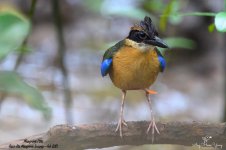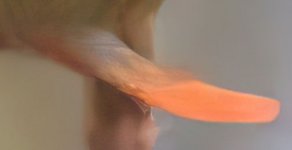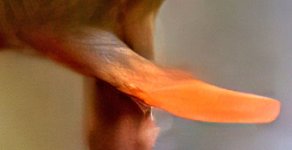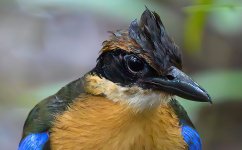-
Welcome to BirdForum, the internet's largest birding community with thousands of members from all over the world. The forums are dedicated to wild birds, birding, binoculars and equipment and all that goes with it.
Please register for an account to take part in the discussions in the forum, post your pictures in the gallery and more.
You are using an out of date browser. It may not display this or other websites correctly.
You should upgrade or use an alternative browser.
You should upgrade or use an alternative browser.
What is that ? (1 Viewer)
- Thread starter Meerkat
- Start date
More options
Who Replied?
Blue winged Pitta with a leech, see The Biodiversity of Singapore

Or a ruffled feather? As to bird penis. Ostrich, ducks, geese all have oneBlue winged Pitta with a leech
iStock
iStock. Die offizielle iStock-Website bietet Millionen exklusive, lizenzfreie Dateien. Um die perfekte Foto, Video oder Vektor finden, nach unserer Sammlung jetzt.
www.istockphoto.com
Deb Burhinus
Used to be well known! 😎

Blue winged Pitta with a leech, see The Biodiversity of Singapore
Or a rather a Mangrove Pitta with a ruffled feather perhaps - it’s far too heavy billed for a Blue-winged! 🙂
Andy Adcock
Worst person on Birdforum

Agree with Mangrove Pitta, never seen a Leech this colour, wonder if it could have picked up a seed of some kind?

Yes, much better fit for the beak. I looked at the item of interest close up and decided that it did not look like a feather. I'm familiar with leeches, though having to rid my wife and myself of over 50 of the things on a short walk through a Sri-Lankan rain forest. Not the same as the peach coloured one in the OP though. I've yet to go to Singapore, except for air transit purposes, on the way back from NZOr a rather a Mangrove Pitta with a ruffled feather perhaps - it’s far too heavy billed for a Blue-winged! 🙂
RafaelMatias
Unknown member

I agree with this. It's a misplaced feather that is just looking as translucent with the light shining through. Note the base of this "appendage" is exactly the same colour as the lower belly/undertail patch (with a bit of grey on the presumed outer web), and only gets the rosy/salmon 'colour' where the light is coming through.Or a rather a Mangrove Pitta with a ruffled feather perhaps - it’s far too heavy billed for a Blue-winged! 🙂
Edwin Sapatsch
Well-known member

Quite an unusal appendage/object would love see it solved. It looks very unleech like and far to large to be a feather of that bird. I hope 'Meerkat' is not offended with my attempts at cropping then clarifying and adding a little contrast to possibly aid in identifying the object.
(If it is indeed a Penis this species should be clasified as being closely related to Equus asinus)
The ruffled head feathers, wet beak and rest of the body seems to suggest the bird had been bathing recently
(If it is indeed a Penis this species should be clasified as being closely related to Equus asinus)
The ruffled head feathers, wet beak and rest of the body seems to suggest the bird had been bathing recently
Attachments
Last edited:
Edwin Sapatsch
Well-known member

Maybe not so odly shaped 'Tired'. Tumors it seems are quite common in birds. I have searched and come across some discriptions of Lipoma and Xanthomas and many fit our subjects protrusion. Sadly I have failed to find any photos but a sketch of one on a parrot looked very similar with 'Peach or Pink'mentioned in the discription. Apparently most are fatty growths and of no danger to the bird.
RafaelMatias
Unknown member

Hello Edwin,
thanks for your enhanced photos. It's interesting how our judgement can be subjective and our perception is probably based on previous experience. For me the photos just show/confirm the 'thingy' is in fact a feather, and the whole structure can be seen there with care, albeit in a low resolution.
The structure is not too long for a ventral feather at all, those feathers can be very long and cross the central belly from each side, concealing the incubation area (where the incubation patch is located during the breeding season).
I could not find ideal Mangrove Pitta photos to illustrate what I mean, but there are some of the similar Blue-winged Pitta:
1) one with a similarly naturally displaced feather (HERE), but seen from below, so that the feather is seen in its full shape in a perfectly ventral angle; the OP photo shows the feather from a frontal angle, looking more 'blade-like'/much narrower.
2) expanding the lower belly feathers (HERE)
3) spreading the lower belly feathers (HERE), so that the skin below (where the incubation patch becomes developed, during the breeding season) becomes visible; these feathers are really quite long.
4) another individual showing displaced feathers (HERE), but here the feathers show the normal orientation (inwards), instead of being twisted outwards as in the OP photo.
thanks for your enhanced photos. It's interesting how our judgement can be subjective and our perception is probably based on previous experience. For me the photos just show/confirm the 'thingy' is in fact a feather, and the whole structure can be seen there with care, albeit in a low resolution.
The structure is not too long for a ventral feather at all, those feathers can be very long and cross the central belly from each side, concealing the incubation area (where the incubation patch is located during the breeding season).
I could not find ideal Mangrove Pitta photos to illustrate what I mean, but there are some of the similar Blue-winged Pitta:
1) one with a similarly naturally displaced feather (HERE), but seen from below, so that the feather is seen in its full shape in a perfectly ventral angle; the OP photo shows the feather from a frontal angle, looking more 'blade-like'/much narrower.
2) expanding the lower belly feathers (HERE)
3) spreading the lower belly feathers (HERE), so that the skin below (where the incubation patch becomes developed, during the breeding season) becomes visible; these feathers are really quite long.
4) another individual showing displaced feathers (HERE), but here the feathers show the normal orientation (inwards), instead of being twisted outwards as in the OP photo.
Deb Burhinus
Used to be well known! 😎

I can’t really see what the difficulty is here with this being a feather but I agree there could be room for a subjective Freudian interpretation for some people 😉
The bird is wet, look at the crown and particular the breast feathers - how the tips of the yellow feathers are darker and matted together.
What I see here and saw too when answering initially, is a dislodged lower belly/vent red/orange vent feather with the feather base (slightly oof) dampened down such that it too is rather matted and lost the ‘fluffy’ shape. The tip is exactly the colour of the vent and the pale greyish white base exactly the colour you would expect of the plumulaceous portion of a feather.
The bird is wet, look at the crown and particular the breast feathers - how the tips of the yellow feathers are darker and matted together.
What I see here and saw too when answering initially, is a dislodged lower belly/vent red/orange vent feather with the feather base (slightly oof) dampened down such that it too is rather matted and lost the ‘fluffy’ shape. The tip is exactly the colour of the vent and the pale greyish white base exactly the colour you would expect of the plumulaceous portion of a feather.

Ok I'm convinced. Thanks Edwin for the blow ups and Rafael for the wordy wordy
Edwin Sapatsch
Well-known member

Yes thanks for clearing it up Rafael, shed tail feather ends protuding through, well done for pointing it out as you did. I could not conceive how the it could be tail feathers but the penny has dropped.
RichieTwitchy
YNWA
"I thought bird don't have a dick?" - what are you, 12?Hi...I'm not sure if this is the right place to ask for information on this.
What is that thing sticking out of the pitta ....I thought bird don't have a dick ?
Surprised no one else has said anything.
But as usual the helpful guys of this forum have at least, maturely, tried to solve your mystery.
Ever thought of thanking them?
Sorry for the late replied...thanks all for the responsed."I thought bird don't have a dick?" - what are you, 12?
Surprised no one else has said anything.
But as usual the helpful guys of this forum have at least, maturely, tried to solve your mystery.
Ever thought of thanking them?
Deb Burhinus
Used to be well known! 😎

That’s a bonus on the ID threads these days unfortunately 😏Ever thought of thanking them?
Users who are viewing this thread
Total: 2 (members: 0, guests: 2)








